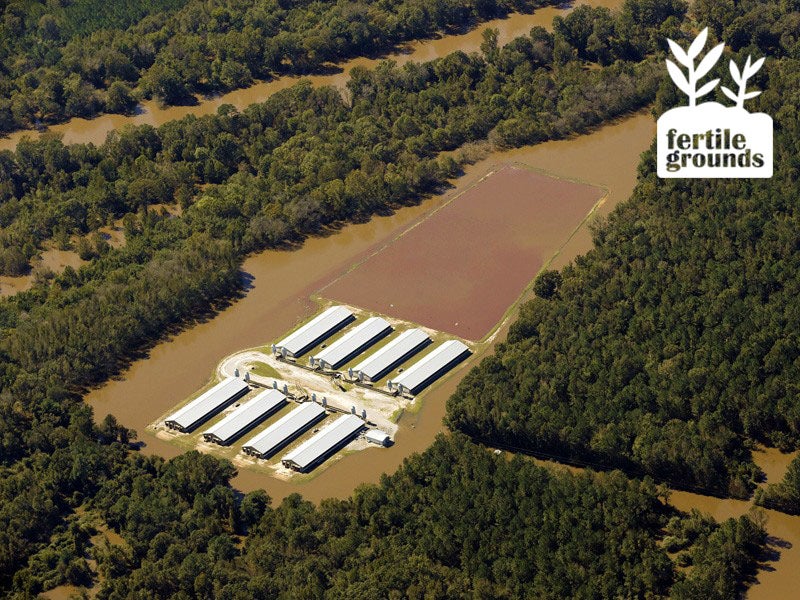A Stench That Sickens, and an EPA That Doesn’t Care
The public can comment through Dec. 14 on an EPA rule that would shield thousands of livestock facilities from reporting toxic emissions.

This page was published 7 years ago. Find the latest on Earthjustice’s work.
This holiday season, the Environmental Protection Agency intends to grant the wish of massive polluters to continue to release toxic emissions without reporting them. Defying recent directives from Congress and the second-highest court in the country, the EPA has proposed a rule that would continue to exempt large-scale factory farms from reporting requirements for pollution that is sickening rural communities.
These factory “farms,” or concentrated animal feeding operations (CAFOs) produce much of the meat that we eat in America. Typically located in rural communities, they hold thousands — or even millions — of animals, in confined spaces, and can produce as much waste as a mid-sized city.
Every day, families living nearby are exposed to toxic ammonia and hydrogen sulfide from the manure created and stored at these CAFOs. Yet, unlike other factories, these meat operations have been given a free pass from reporting their toxic emissions.
Earthjustice has been working with community and environmental groups to push the EPA to address pollution from animal feedlots for decades. In April 2017, the U.S. Court of Appeals for the D.C. Circuit ruled that the EPA could not exempt massive livestock facilities from the pollution reporting law that normally applies to all polluting facilities.
As the court explained in its ruling, “anyone with a pet knows firsthand that raising animals means dealing with animal waste. But many of us may not realize that as the waste breaks down, it emits serious pollutants — most notably ammonia and hydrogen sulfide. While those emissions are miniscule for pet owners, they can be quite substantial for farms that have hundreds or thousands of animals.”
However, instead of following the court’s ruling and heeding directives from Congress, the EPA has proposed a sweeping exemption that that would shield the largest livestock facilities from reporting. EPA is accepting comments on its new exemption until December 14. Please tell the EPA to withdraw this proposed rule through this easy form.
While polluters are benefiting from the EPA’s dereliction of duty, people who live near these facilities continue to suffer. Iowa farmer Rosemary Partridge has worked with Earthjustice since 2015 to demand better oversight of industrial animal agriculture. Her home is surrounded by 30,000 hogs concentrated in factories near her farm.
“During the summer we can’t keep our doors or windows open because of the stench,” she writes in a blog post describing her situation. “If I’m outside, my clothes smell like pig feces when I come home. Sometimes it gets so bad [my husband and I] get headaches and feel nauseous.”
Toxic gases from animal waste, which is often stored in open pits and sprayed over fields, include substances like hydrogen sulfide and ammonia that are linked to nausea, headaches, and chronic lung disease. Children in nearby schools have a heightened risk of asthma. Dairy farm workers have fallen into manure pits and drowned after being overcome by the toxic fumes that emanate from all that animal waste.
A new Duke University study shows that people living in communities with the highest density of hog operations experienced 30 percent more deaths among patients with kidney disease, 50 percent more deaths among patients with anemia, and 130 percent more deaths among patients with sepsis, as compared to people in communities without big hog facilities.
Feedlots tend to be clustered in low-income communities, and in some parts of the country, especially the Southeast, in communities of color. Earthjustice and others brought a civil rights complaint in 2014, which the EPA found to have merit, over the concentration of hog farms in North Carolina.
Despite these harms, the EPA continues to turn a blind eye to pollution from industrial animal agriculture. The agency has tried three times to block this particular set of reporting requirements, first suspending them in 2005, then trying to push through an illegal exemption in 2008, which was rejected in court, and now, this latest last-ditch attempt to make the exemption even broader.
On behalf of Waterkeeper Alliance, Sierra Club, and several local environmental groups including Rural Empowerment Association for Community Help, Earthjustice filed a lawsuit on Sept. 28 challenging the EPA’s illegal “guidance” instructing CAFOs not to report their toxic emissions. This follows Earthjustice’s Sept. 14 lawsuit to force the agency to disclose public records that could shed light on its decision to keep pushing for this exemption.
A recent stinging report from the EPA’s independent Office of the Inspector General recommends that the agency stop shielding polluters. It has a duty to protect public health, but time after time, the EPA has fallen down on the job. Make your voice heard by submitting a public comment against the EPA’s proposed rule.
Established in 2008, Earthjustice’s Northeast Office, located in New York City, is at the forefront of issues at the intersection of energy, environmental health, and social justice.